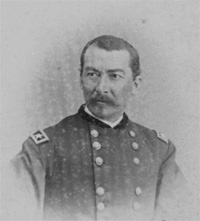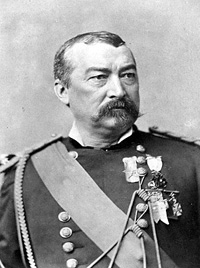
Philip H. Sheridan
Philip Sheridan’s parents came to America in 1830, and Philip was born on March 6, 1831. There are no records of his birth. At various times, Philip claimed that he was born in Albany, New York, Boston, Massachusetts, and Somerset, Ohio.
He was raised in Somerset, where he attended school until the age of 14, at which time he went to work as a store clerk until he was appointed to West Point in 1848.
Sheridan had a fierce temper. After threatening an older cadet with a bayonet during his third year at the military academy, he was suspended for a year, returning to graduate in 1853, 34th in a class of 49.
Following his graduation, he served in Texas and in the Pacific Northwest during the late 1850s. Promotions were traditionally slow for infantrymen, and Sheridan was no exception to that rule. The outbreak of the American Civil War found him in Missouri, with the rank of Captain, serving as quartermaster in the Army of the Southwest, under the command of General Samuel Curtis.
A sloppy bookkeeper with a hot temper, he barely escaped court martial, instead joining General Halleck’s staff performing various tasks as a supply officer.
He managed to convince General Halleck that he would be of more use in the field, and was again assigned to General Curtis, who was preparing a campaign to drive the Confederates out of southern Missouri.
In May of 1862, he was commissioned Colonel of the 2nd Michigan Cavalry where he excelled, taking command of the brigade only two months later.
His aggressive handling of his cavalry position earned him promotion and an infantry command. In October, he led a division at the battle of Perryville, Kentucky. His stubborn refusal to give ground at Stone’s River earned him promotion to Major General.
He saw action at Chickamauga in September, 1863. The following month, he led an impulsive charge up Missionary Ridge near Chattanooga that proved widely successful.
On March 12, 1864, after General Grant was appointed General in Chief of the Union Armies, he appointed Sheridan Chief of Cavalry, Army of the Potomac.
Sheridan’s chief area of operation was the Shenandoah Valley, where he contested General Early’s Confederate troops, destroying crops and other support systems of the Confederacy, and defeating and killing General J.E.B. Stuart, the famous cavalry leader of the South. At the battle of Cedar Creek, he  drove Early out of the valley altogether.
drove Early out of the valley altogether.
As the war came to an end, Sheridan was instrumental in forcing Lee out of his Petersburg, Virginia defenses, cutting off his retreat at Appomattox.
At the end of the American Civil War, Sheridan took charge of the U.S. Army on the Rio Grande in Texas. With 50,000 troops at his command, he was credited with achieving a show of force intended to keep the French from interfering in Mexico.
He later served as postwar governor of Texas and Louisiana, enforcing reconstruction policies so aggressively that President Johnson arranged his recall.
Assigned to command the Department of the Missouri, Sheridan organized a punitive campaign against the Plains Indians in the 1870s. The infamous dictum, “The only good Indian is a dead Indian” is a version of a phrase used by Sheridan: “The only good Indians I ever saw was dead.”
He led the Marias River massacre in Montana, in which 173 Piegans were brutally slaughtered.
In 1875, he married, and had four children. He retired in 1883, and a few years later, in 1888, he suffered a series of heart attacks. Congress revived the grade of full General and Sheridan was given his fourth star by President Grover Cleveland, only the fourth man in U.S. history to be so honored. On August 5, 1888, he died in Nonquit, Massachusetts, and was laid to rest in Arlington Cemetery.